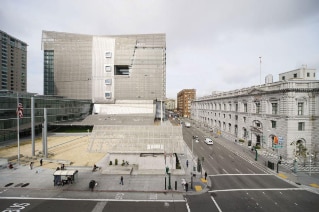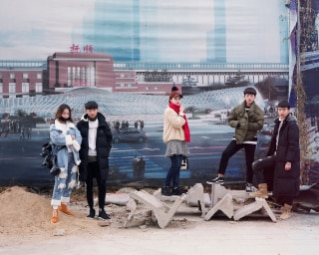In the space of just a few days, bad news has struck two buildings constructed by the studio Venturi & Scott Brown, the Abrams House in Pittsburgh built in 1979 (the same year as La condition postmoderne) and the San Diego Museum of Contemporary Art, which was completed in 1996. In the first case, the owner of another adjacent villa, the Giovannitti House designed by Richard Meier at the beginning of the 1980s, purchased the building in order to expand his property, beginning refurbishment works on the quiet, including the removal of a fresco by Roy Lichtenstein from the living room; in the second case, there is a project for minimalist expansion works which threatens to demolish the wing added by V&SB to the museum, which is constructed around an original building from 1915 by Irving Gill, the pioneer of modern architecture in South California. All of this is taking place after a project in 2007 by Brad Cloepfil deformed and inexorably altered expansion works by the duo from Philadelphia carried out on the Seattle Art Museum, and after the 1969 Lieb House was saved at the last second thanks only to a collector who purchased it and moved it on a barge from New Jersey to a new property in Long Island.

PoMo has the defect of being out of fashion while not being old enough to be re-evaluated, while a new generation of architects who grew up during the period of re-evaluation of these reference points is now emerging.– Denise Scott Brown
This all begs the question that if the work of famous architects from the post-modern period is under threat, perhaps all that production is in danger, be it due to building speculation, or to a refusal to acknowledge that aesthetic interlude in the name of an undefined form of “neomodernism”, as defined during a telephone conversation by Denise Scott Brown. “PoMo has the defect of being out of fashion while not being old enough to be re-evaluated, while a new generation of architects who grew up during the period of re-evaluation of these reference points is now emerging. Luckily, the extension of the Sainsbury Wing of the National Gallery in London has been listed for protection”.

On 31 July, Johnson’s AT&T Building di Philip in Manhattan – he of the famous 1979 Time Magazine cover – was recognised by the Landmarks Preservation Commission as a building to be protected, thus halting the transformation project for its base included in the restructuring works currently being carried out by Snøhetta, harshly critical of architects such as Norman Foster, Robert A. M. Stern and journalists such as Oliver Wainwright. Furthermore, a few days ago the architects Gilbert and Christian Stayner purchased the 1955 Wave House by Walter S. White in the Palm Desert in California maintaining the authenticity of a building which, on paper, appears “modern”, but which is in fact Turkish in style with a waved roof that was to be the forerunner for many examples in the 1980s.
Many postmodern buildings are at risk of demolition at the very moment that a mass of young scholars and critics throughout Europe and the USA are carrying forward the legacy of the postmodern figurative canon.
The fact is that many postmodern buildings are at risk of demolition at the very moment that a mass of young scholars and critics [1] throughout Europe and the USA are carrying forward the legacy of the postmodern figurative canon, which only in architecture managed to find a collocation that despite not being perfectly defined, is at least accepted. Having burst forth after the Biennial by Paolo Portoghesi in 1980 (but in reality already present beneath the ashes of radical architecture, and the more polished style of “Oppositions”), the “end of citationist, historicist and anti-functionalist prohibition” had very strong echoes in design, from Memphis by Ettore Sottsass & Co., and in fashion, particularly in the global domination of Swatch watches under the artistic direction of Alessandro Mendini. Following years of the SuperDutch and those of the rappel à l’ordre, Postmodernism re-emerged with the millennial [2] generation, also due to videos, from Katy Perry to Thegiornalisti. The latest example which is representative of a general trend is the recent theatre by Matteo Ghidono at the Milan Triennale, a mishmash of allusions to Aldo Rossi (the ephemeral wooden theatre), Sottsass (the self-definition of “pagan temple”, the gaudy colours on the backdrop) and Rem Koolhaas (the balloon).

Postmodernism is not the sinful and frivolous invention of a few, it is not a form of poetry which cancelled the anguished seriousness of the Modernists and substituted it with the playful use of ephemeral shapes.– Alfonso Berardinelli
Going back to Venturi and Scott Brown, now very elderly and unable to defend themselves properly, much could be done to raise awareness by the upcoming documentary film Learning from Bob & Denise by their son Jim Venturi, who previously made Saving Lieb House in 2009 (with John Halpern). It is difficult to resolve the question here, but what remains valid however is the opinion of a great critic, Alfonso Berardinelli: “Postmodernism is not the sinful and frivolous invention of a few, it is not a form of poetry which cancelled the anguished seriousness of the Modernists and substituted it with the playful use of ephemeral shapes. As is the case with Modernism, Postmodernism also has at least two sides. On the one hand, it could be seen as the rhetorical response to a form of extremism which was too programmatic even for famous past avant-garde movements. On the other, Postmodernism was, over the course of half a century, from 1945 onwards, a historical situation which involved contrasting cultural trends: neorealism, nouvelle critique, nouveau roman, neomarxism. Novels such as House of liars, Lolita, The Leopard, films such as The Discreet Charm of the Bourgeoisie and Barry Lyndon, poets such as Ponge and Auden, or Pier Paolo Pasolini, Magnus Enzensberger, Álvaro Mutis and Derek Walcott are aware that there was no more energy or space for modernist progressivism and the formal search for the boundless new in the mid-1900s. There were no more traditions or rules to break, but rather forms to return to and vary for other uses, contaminating genres rather than cancelling them [3]”. This needs to be taken into account, before demolishing buildings which are currently “out of fashion”.
Notes
[1] Cf. Léa-Catherine Szacka, Veronique Patteeuw, Mediated Messages Periodicals, Exhibitions and the Shaping of Postmodern Architecture, Bloomsbury, London 2018.
[2] Glenn Adamson, Jane Pavitt, edited by, Postmodernism: Style and Subversion, 1970-1990, Victoria & Albert Publishing, London 2011.[3] Alfonso Berardinelli, Casi critici. Dal postmoderno alla mutazione, Quodlibet, Macerata 2007, pp. 11-12.
[3] Alfonso Berardinelli, Casi critici. From Postmodernism to Mutation, Quodlibet, Macerata 2007, pages 11-12.







